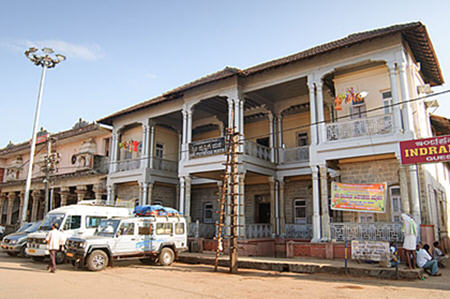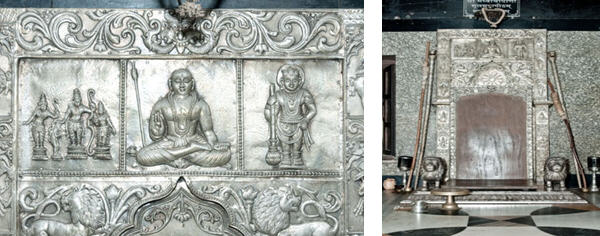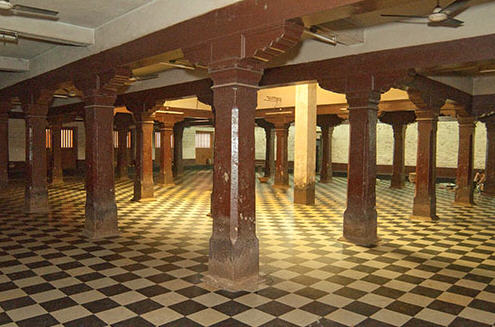The day's activity commences exactly at 4 a.m. with the blowing of the conch and the beating of the 'Nagari' in the gopuram outside the Matha premises. With this the Swamiars and other employees of the Matha wake up, attend to their ablutions and take their bath. With the ringing of the bells outside, they open the door of the garbhagriha. Then they open the door of the inner room to the beating of 'Jaghante.' The assistants get things ready for the early morning puja and take the Utsava Murthi to the Madhwasarovara and give it a bath by pouring water over it. Cooks start on the preparation of Rice, Payasam and Dosas for Naivedya. Other assistants start on the grinding of sandal paste for the puja.
(The Karnataka Government sends a little more than 4 tons of sandal wood every year for this purpose.)
Nirmalya Visarjana
By about 5 a.m. the Swamiyar having completed his daily japa and tarpana commences the first puja. After removing the decorations, ornaments, apparel, flowers and tulasi of the previous day, the deity is bathed and bedecked with Tulasi garland. Soaked Bengal gram, Curd and Beaten rice, Jaggery, Ginger, Coconuts, plantains and betel leaves are offered as naivedyam and the puja is performed as per instructions laid down in Tantrasara.
Ushahkala Puja

Immediately after this, the next puja commences. Holy water for the God's abhishekha which is stored in silver vessels is then worshipped and with that water, the deity is bathed again and bedecked with Tulasi, flowers and sandal paste. Pots of cooked rice, coconuts, plantains, curds, milk, betel leaves are again offered for naivedyam and mangalarathi is raised to the accompaniment of pipe music.
Go-Puja
After this, an offering of puffed rice, ordinary rice and jaggery is made to the God and another arathi is raised to the God. The same arathi is raised to a Cow also and this offering of puffed rice, jaggery etc. is distributed to the cows which crowd inside the Matha at this time everyday.
Panchamrita Puja
After this, the balaroopa decoration of the Lord is removed and to the accompaniment of recitation of the three Vedas and the music of pipes, drums, nagari etc., an abhishekha in gold coins is performed and a mangalarathi is raised. Then the deity is bathed with ghee, milk, curd, honey and jaggery one after the other. It is then bathed with tender coconut water and bedecked with Tulasi and flower garland, Sandal paste etc., and after the usual offerings of pots of cooked rice etc., mangalarathi is raised. Beating of the nagari indicating this abishekha starts even 15 minutes before the commencement of the abhishekha. Small portions of these Panchamritha abhishekha material are sent to Sri Mukhyaprana and Sri Subrahmanya temples for their abhishekha.
Udvartana Puja
The deity is then bathed in perfumed water and cleaned of all greasy matter by washing it with green gram flour. Offerings of tender coconuts, milk and butter are made and a mangalarathi is raised. Again the deity is bathed in water from silver Kalasha and bedecked with Tulasi, flowers and sandal paste. Offerings of coconuts, plantains, milk, curds, pots of cooked rice are made and mangalarathi is raised.
Kalasha Puja
Thereafter, in front of the deity, Kalasha puja is performed to gold vessels full of water. The offering of cooked rice of this puja is re-offered to Garuda and then thrown into the Madhwasarovar as a feed for the fish.
Theertha Puja
The holy water from the gold vessel is used for the main abhisheka. The deity is then dried with a clean piece of cloth and bedecked with tulasi garlands, flowers and Sandal paste. Offerings of cooked rice, payasam, dosai, coconuts, plantains, betel leaves etc. are made and mangalarathi is raised. The holy water from this abhisheka is available as theertha for the devotees and hence this puja is known as theertha puja. The offerings of this puja are re-offered to Sri Mukyaprana and served to brahmins in the general dining hall (Bhojana shaja).
Alankara Puja

The deity is then decorated with various gold ornaments and laced silk apparel and bedecked with tulasi and flowers in a very attractive way. This decoration time is indicated by the continuous beating of nagari outside. Offerings of pots of cooked rice, sweets, laddu, milk, curds, coconuts, bananas and betel leaves are made and to the singing of hymns and songs by the Matha musicians, mangalarathi is raised. This puja is known as alankara puja. On Fridays and during Navarathri festival, the deity is decorated in feminine form. On other auspicious occasions, the decorations take the form of many avatars of the lord depicting some puranic or mythological incidents. In fact, this decoration of the deity which is in a most attractive way is one of the peculiarities of this math. The offerings of this puja are served to guests in the Mrishtana pankti
Avasara Puja
This puja is also known as Sanakadi puja, After making the usual offerings of cooked rice, coconuts etc, arathi is raised.
Maha Puja

Mahapuja or the most important puja of the day follows immediately after Avasara Puja. It is performed by the Paryaya Swamiyar himself who starts with the usual offering of sandal paste, Tulasi and flowers to the God to the recitation of Brahmasutra, Vishnusahasranama, Krishnastotra etc. Then the naivedya articles such as pots of cooked rice, many varieties of sweets and eatables, payasam, panchakajjaya, laddu, coconuts, plantains, betel leaves etc. are placed before the God. The Swamiji then comes outside and closes the door of the sanctuary. It is believed that Sri Madwacharya himself makes the offereings to God and worships Him. At this time pipe music goes on and drums and nagaries beat ; Math musicians sing bhajans and Dwadasa Stotra; purohits perform a homa called Anuyaga in a room nearby and brahmins are fed in Mrishtanna. After some time Swamiji goes in and performs many mangalarathis. At this time two country guns are fired as signal of this puja. People in the neighbourhood come to know from this that Lord Krishna's Mahapuja is going on and pious people usually take their meal only after this.
The beating of the nagari is different for Panchamrita, Alankara and Mahapuja and a trained ear can always find out from this which puja is going on at any particular time and come to the Matha accordingly.
Barring the Kalasa puja, the other nine pujas described above are performed to Lord Sri Krishna during day time. Of these the Paryaya Swamier has to do personally the Pancharmrita puja, Avasarapuja and Mahapuja. In any case Avasara puja and Mahapuja are to be performed by the Paryaya Swamier himself. Other pujas can be performed by Swamies of any of the other Maths who generally stay in Udupi to assist the Paryaya Swamier.
The Swamies then performs Uttarapuja and dedicating all the morning pujas to the God, comes out to perform the puja of Sri Mukhyaprana. At this time Vedic hymns are chanted and Keertanas are sung.
Sri Mukhyaprana Puja
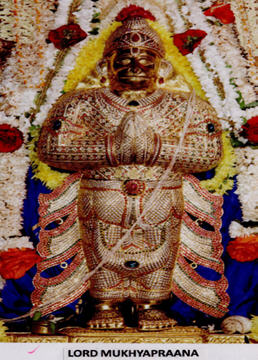
The naivedyams offered to Sri Krishna during the Mahapuja are reoffered to Sri Mukhyaprana and the paryayam Swamier performs mangalarathi. Besides, the Swamiers who perform the other pujas of Sri Krishna also raise arathies for Sri Mukhyaprana and Sri Madhwacharya.
Sri Madhwacharya Puja
Then the Paryaya Swamier comes to the deity of Sri Madhwacharya and making the same offering of Sri Krishna's Naivedya, performs a puja.
Simhasana Puja
Then he comes to Simhasana and making the usual offerings to the gods there, raises a mangalarathi.
Pradakshina Namaskara
Then as the chanting of hymns, playing of music and singing of songs are going on, the Swamier goes round the deity four times and after namaskaram or prostration, proceeds to the Madhwasarovar where he offers oblations to the departed souls of his line. After performing the puja of Goddess Bhagirathi and throwing the offerings to the tank as a feed for the the fish, he proceeds to the Vrindavan.
He then worships the vrindavana of this ancestors and after going round the Ashwatha tree, returns to Simhasana. There cows are fed. This is known as Gograsa.
In the simhasana, he takes his seat on a raised platform which is reputed to be the original seat of Sri Madwacharya. He then distributes Teertha, tulasi and sandal paste to all the Swamiers assembled there in the order of seniority and also to all the invited guests. Sri Madhwavijaya is recited on the occasion. Then he proceeds to the dinning hall called chouki and when every one is seated and served, he commences his meals. A sumptuous meal is served here to all the invitees. During meal time,- portions of Ramayana purana is read by a pandit and translated into Kannada. After meals the Parayaya Swamier comes back to Simhasana, takes teertha and nirmalya, and going round the deity completes his work for the noon.
In the general dining hall, after all people and students are fed, the left over is given to bairagees and beggars. Nagari is beaten to indicate the time once at 12 noon and again at 6 P.M.
Chamara seva

At about 7 P.M. every night the Paryayam Swamier himself perfoms this puja after his evening bath, tarpana and japa. The puja is offered to sacred books, shaligram and a vigraha which are kept on a peeta on the mantapam in front of the deity of Sri Krishna. The Swamier starts the puja with the Chamaraseva with two gold chamaras. Pipe music goes on at this time. Math musicians sing Keertanas. Two boys holding gold sticks (dandas) keep on waving green silk cloth on either side. Two huge basket full of puffed rice, jaggery, coconut, laddus, betel etc. are offered for naivedyam. Two big torches burn on either side. A mangalarathi is raised first for the Lord, then the same thing is raised to Sri Mukhyaprana. Then he worships the god inside Simhasana. Beating of nagari commences outside indicating that the next puja is about to begin.
Ratri puja
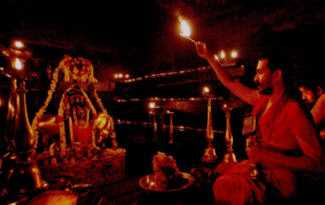
Some other Swamier, by this time gets ready for the next puja after his bath and daily tarpana and japa. He worships the God by floral and tulasi offerings, The naivedyam consists of pots of cooked rice, ghee, jaggery, tender coconut and milk. A number of mangalarathi is raised on this occasion as the music and chanting of hymns continues.
Ranga puja

After this, four pots of panchakajjaya are spread on plantain leaves in a line in front of Sri Mukyaprana. Rows of wick lamps are lighted on either side and mangalarathi is raised. After Sri Madhwacharya's puja, the Utsava murthi is kept in a palanquin and taken outside if there is any chariot Utsavam. Otherwise it is taken round the Math in the inside itself and kept on a silver cradle fixed in the mantapam. With the usual offering, a mangalarathi is raised as green silk "cloth on either side is waved by dandadharies and chamaras are waved. Bhaktas engage themselves in Sankeertana. Then the singing of ashtaka songs and recitations from scriptures Continues for some time. After this, mangalarathi is raised to the Swamiers on important occasions manthrakshata is distributed by the Swamier to the assembled persons. The Utsava murthi is then placed in the palanquin and taken round the Math slowly to the sweet music from the flute and again a mangalarathi is raised as Uttarapuja.
Ekantaseva
Inside the garbhagudi\s a golden cradle with a silken bed in it. The murthi is kept in it. Puffed rice, laddu, milk, fruits and betels are offered; scents and perfume are offered; arathi is raised and lullaby is sung thus putting the god to sleep. The Paryaya Swamier then honours the other Swamiers present, with sandal paste, sandalwood oil and flowers and thus completes the day's work. The blowing of a conch indicates that all the daily rituals have been completed.
















